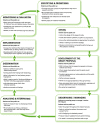Frameworks for supporting patient and public involvement in research: Systematic review and co-design pilot
- PMID: 31012259
- PMCID: PMC6737756
- DOI: 10.1111/hex.12888
Frameworks for supporting patient and public involvement in research: Systematic review and co-design pilot
Abstract
Background: Numerous frameworks for supporting, evaluating and reporting patient and public involvement in research exist. The literature is diverse and theoretically heterogeneous.
Objectives: To identify and synthesize published frameworks, consider whether and how these have been used, and apply design principles to improve usability.
Search strategy: Keyword search of six databases; hand search of eight journals; ancestry and snowball search; requests to experts.
Inclusion criteria: Published, systematic approaches (frameworks) designed to support, evaluate or report on patient or public involvement in health-related research.
Data extraction and synthesis: Data were extracted on provenance; collaborators and sponsors; theoretical basis; lay input; intended user(s) and use(s); topics covered; examples of use; critiques; and updates. We used the Canadian Centre for Excellence on Partnerships with Patients and Public (CEPPP) evaluation tool and hermeneutic methodology to grade and synthesize the frameworks. In five co-design workshops, we tested evidence-based resources based on the review findings.
Results: Our final data set consisted of 65 frameworks, most of which scored highly on the CEPPP tool. They had different provenances, intended purposes, strengths and limitations. We grouped them into five categories: power-focused; priority-setting; study-focused; report-focused; and partnership-focused. Frameworks were used mainly by the groups who developed them. The empirical component of our study generated a structured format and evidence-based facilitator notes for a "build your own framework" co-design workshop.
Conclusion: The plethora of frameworks combined with evidence of limited transferability suggests that a single, off-the-shelf framework may be less useful than a menu of evidence-based resources which stakeholders can use to co-design their own frameworks.
Keywords: codesign; framework; hermeneutic review; patient and public involvement; systematic review.
© 2019 The Authors Health Expectations published by John Wiley & Sons Ltd.
Conflict of interest statement
None declared.
Figures





References
-
- Wicks P, Richards T, Denegri S, Godlee F. Patients' roles and rights in research. BMJ. 2018;362:k3193. - PubMed
-
- Ward PR, Thompson J, Barber R, et al. Critical perspectives on ‘consumer involvement' in health research: epistemological dissonance and the know‐do gap. J Sociol. 2010;46(1):63‐82.
-
- Madden M, Speed ES. Beware Zombies and Unicorns: towards critical patient and public involvement in health research in a neoliberal context. Front Sociol. 2017;2:7.
-
- Oliver S, Liabo K, Stewart R, Rees R. Public involvement in research: making sense of the diversity. J Health Serv Res Policy. 2015;20(1):45‐51. - PubMed
Publication types
MeSH terms
Grants and funding
LinkOut - more resources
Full Text Sources

